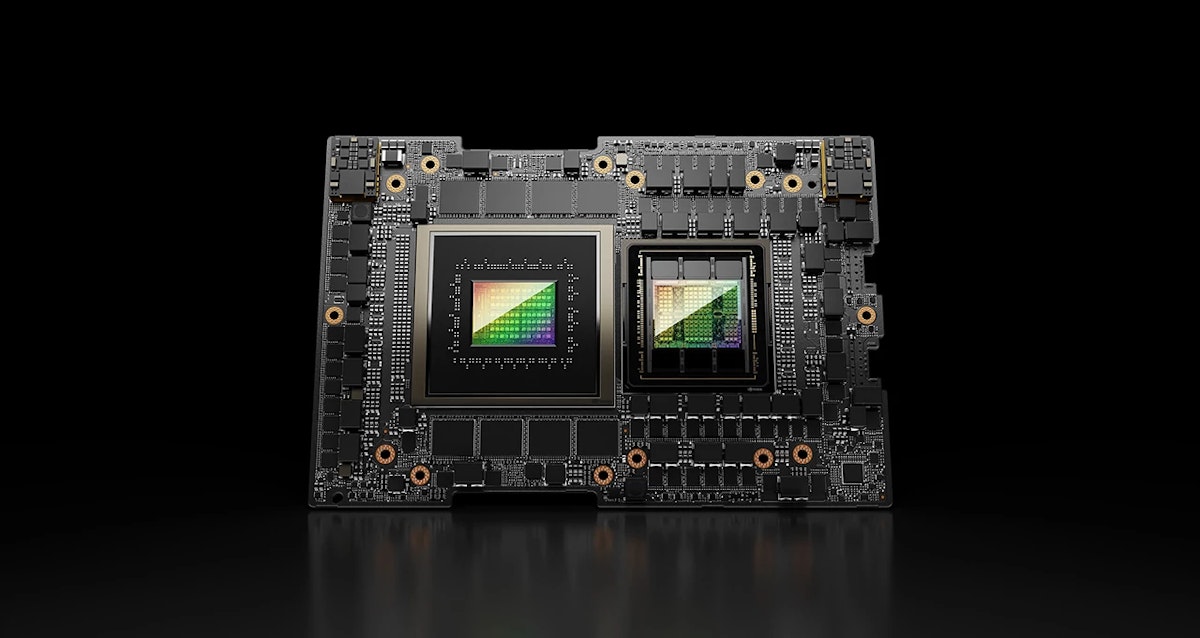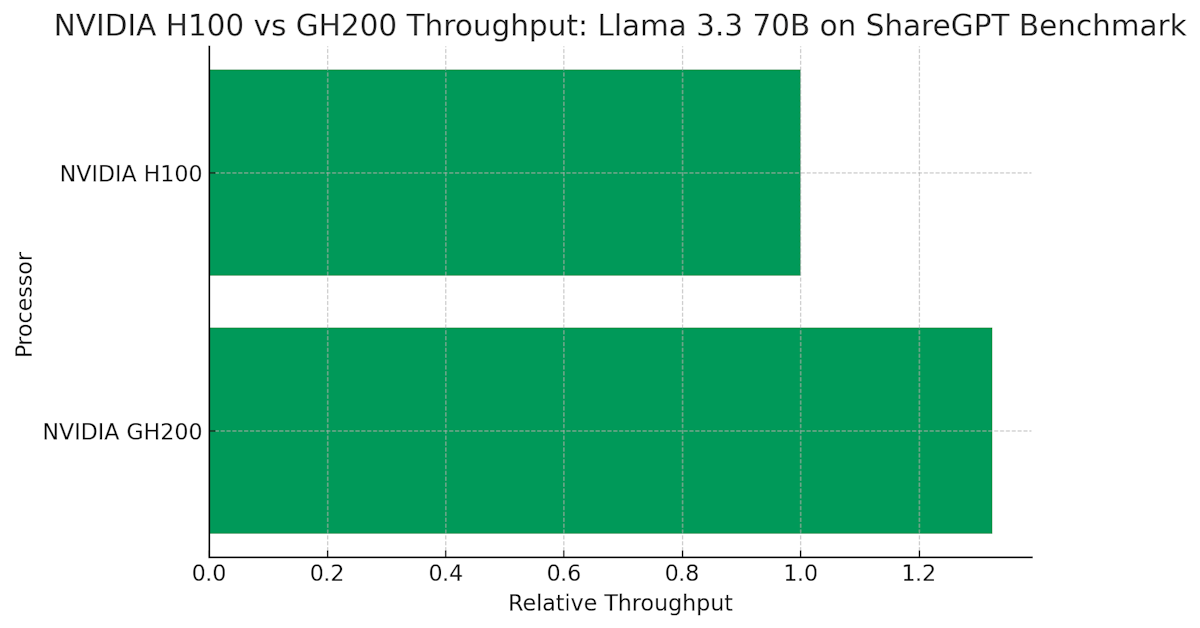Partner Spotlight: Testing Llama 3.3 70B inference performance on NVIDIA GH200 with Baseten

The NVIDIA GH200 Grace Hopper™ Superchip is a unique and interesting offering within NVIDIA’s datacenter hardware lineup. The NVIDIA Grace Hopper architecture combines an NVIDIA Hopper GPU with an ARM CPU via a high-bandwidth interconnect called NVLink-C2C. This is a similar architecture to the Grace Blackwell Superchip in GB200 NVL72.
This GPU-plus-CPU architecture is promising for AI inference workloads that require extremely large KV cache allocations. We leveraged a GH200 instance from our friends at Lambda to test how this architecture translates to real-world performance.
In this article, we’ll break down what makes the GH200 architecture interesting, what potential it has for high-performance inference, and the results from our early experiments serving Llama 3.3 70B on the 96GB GH200.
GH200 vs H100 and H200
The GH200 Superchip has the exact same compute profile as the NVIDIA H100 GPU and NVIDIA H200 GPU and has two different memory profiles available:
|
Hardware
|
H100
|
GH200 (96 GB)
|
GH200 (144 GB)
|
H200
|
|---|---|---|---|---|
| FP16 Compute (Sparse) | 1979 TFLOPS | 1979 TFLOPS | 1979 TFLOPS | 1979 TFLOPS |
| FP8 Compute (Sparse) | 3958 TFLOPS | 3958 TFLOPS | 3958 TFLOPS | 3958 TFLOPS |
| GPU memory | 80 GB HBM3 | 96 GB HBM3 | 144 GB HBM3e | 141 GB HBM3e |
| GPU memory bandwidth | 3.35 TB/s | 4.0 TB/s | 4.9 TB/s | 4.8 TB/s |
However, the GH200 has the ARM CPU with a fast interconnect. While a server built around an H100 GPU has up to 64 GB/s in one-way bandwidth between the GPU and CPU, the GH200 Superchip has up to a 450 GB/s interconnect in each direction between its onboard CPU and GPU.
Thanks to this high-speed interconnect on GH200, it’s feasible to offload parts of the KV cache in the abundant CPU memory rather than the limited GPU memory during inference.
GH200 for model serving
GH200s offer theoretical advantages over H100 GPUs on both phases of LLM inference:
-
Prefill, which generates the first token, is often compute-bound. While the GH200 doesn’t offer any extra compute, offloading the KV cache to abundant CPU memory offers extra space for prefill optimizations like prefix caching and KV cache re-use.
-
Generation, which creates all subsequent tokens, is often memory-bound. The GH200 offers a higher memory bandwidth than the H100, improving generation speeds.
However, the H100 and H200 GPUs can be assembled in nodes of 8 GPUs connected via low latency NVLink and NVSwitch to serve extremely large models like Llama 405B on H100s or DeepSeek-V3 on H200s. Meanwhile, the GH200 is available as a single node or a dual node, called GH200 NVL2 that fully connects two GH200 Superchips with NVLink. Hence for our experiments we chose the Llama 3.3 70B model which can fit on a single 96GB GH200 Superchip.

Experiment: Llama 3.3 70B on a single 96GB GH200 GPU
We generally serve Llama 3.3 70B on a 2xH100 GPU instance in FP8, or a 4xH100 instance when FP16 is necessary. But is it possible to serve the model on a single GPU?
In FP8, Llama 3.3 70B requires 70 gigabytes of VRAM to load the weights. Quantizing to INT4 is possible, but that generally results in a substantial loss in quality as measured by perplexity. Sticking with FP8, we only have 10GB of VRAM left on an 80GB H100 or 27GB left on the 96GB GH200. While this is enough space to store active KV cache for some workloads, it doesn’t leave much room for KV cache re-use.
Serving Llama 3.3 70B on GH200 allows us to take advantage of the benefits of the superchip’s unique architecture. While the active KV cache stays on the 27GB of available memory during inference, we can store additional KV cache data on CPU memory to re-use and use for prefill, unlocking these optimizations while running inference on a single GH200 Superchip.
Inference setup
We tested Llama 3.3 70B in FP8 on a single H100 GPU instance as a baseline and GH200 to see what improvements we’d get from KV cache re-use. While this isn’t necessarily a configuration you’d use in production, it does give useful insights into the GH200 Superchip’s capabilities.
We built an optimized inference engine for both hardware options using our TensorRT-LLM Engine Builder.
Benchmark setup
While we used TensorRT-LLM to build the inference engines, we used SGLang’s benchmarking tool to gather performance data as it has a built-in KV cache re-use test.
For the inference sample, we ran the ShareGPT benchmark to simulate standard chat data. We ran our server with a batch size of 32 and configured our benchmark for full utilization.
Benchmark results
In our testing, the GH200 Superchip outperformed the H100 GPU by 32%. The GH200 Superchip only has 21% higher VRAM bandwidth and an identical compute profile – the rest of the performance gains came from having access to a larger KV cache.

The performance gain varies by input and output sequence length. We used the ShareGPT benchmark to ensure this testing blends a range of realistic sequence lengths to simulate actual traffic, so our results may differ from other benchmarks. To check specific sequence lengths, see results from NVIDIA’s testing on KV cache offload performance, which found that the performance gain increased as the input sequence length grew.
These benchmarks were designed to explore the unique capabilities of the GH200 Superchip rather than to perfectly simulate production use. In future experiments, we anticipate more robust performance from upgrading to the GH200 NVL2 and testing use cases with significant prompt caching requirements.
Conclusion: LLM serving on NVIDIA GH200
NVIDIA GH200 is an interesting processor with advantages over x86-based H100 GPUs for both prefill and generation in LLM inference. With an optimized engine, you can run high-throughput deployments of models that wouldn’t fit on a standalone GPU with the same VRAM profile. The same architecture that connects the CPU with the GPU via NVLINK-C2C powers the GB200 Grace Blackwell Superchip, which promises to be extremely powerful for model inference and supports multi-node NVLink for serving larger models.
Hopper GPUs offer several excellent options for model serving in addition to the GH200, including our daily-driver H100 GPUs and H100 with MIG Slices for high-performance inference on smaller models, and H200 GPUs for extremely large models like DeepSeek-R1.